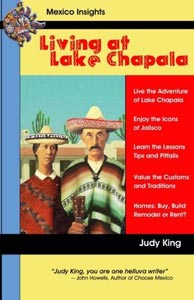Good Reading
A Mexico guidebook by Judy King
 Living at Lake Chapala
Living at Lake Chapala
By Judy King
Mexico Insights Books, 2013
Available from Amazon Books: Paperback
Judy King’s Living at Lake Chapala is a must have book for any expatriate living at Lake Chapala, and it is a very useful book for any expatriate anywhere in Mexico. It is a book to keep beside the bed, or on the coffee table, or even on the car seat. Arranged in six parts, the 76 chapters tell you just about everything you could want to know about living the Mexico adventure.
Part One
Come for the Adventure informs you about the real cost of living here, with a study of six different households. You will also learn about the near perfect climate (although Judy recommends moving here for the adventure rather than the climate). This section concludes with “Expect the Unexpected:” “the dog herding a dozen goats past the front door” or the milkman, bareback on his horse, talking on his cell phone.
Part Two
The Adventure That is Mexico relates to us the early history of Lakeside but also tells us about mariachi music, what the daily church bells mean and how to tell time by them (more complicated than in the rural US), death and funeral customs, and even tequila (I discovered my favorite tequila, 7 Leguas, was named for one of Pancho Villa’s favorite horses). The chapter on Mexican manners exhorts us to “never toss something to a Mexican,” to shake hands gently, and to speak formally when meeting someone. Part Two also has a chapter many find very useful, “Learn Spanish — My Way.” (One woman told me that chapter itself was worth the price of the book.)
Part Three
Beginning the Adventure starts with “Judy’s Amazing Journey.” It cautions us to drive very defensively because “There is still no formal driver’s training for Lakeside drivers,” “Many of today’s drivers have never read the rule book, taken the written test, or obtained a driver’s license,” and “Bicyclists are unaware that driving rules also apply to them.” Judy also provides a list of what to pack in your “Safety and Security Bag” but also in your “Silly Luxuries for Longer Trips:” fly swatter, corkscrew, 100-watt bulb for hotel room, Kindle, and so on. Ten of the chapters in this section are devoted to housing, whether renting or buying, and they include an English-Spanish glossary of building terms…for example, garage is cochera, a locksmith is a cerrajero, a sidewalk is a banqueta, a swimming pool is an alberca, light bulbs are focos, and, thank God, a closet is a closet.
Part Four
Adjusting to the Adventure warns us that it is a cash society, checks are rarely used, and business is conducted in pesos. And…”Bring your whole kitchen” and forget about high heels and ties. We also learn that there are laws in effect that apply to our relationships with our maids and gardeners, and that for workers, full and part-time who have been with us for more than one year, vacation pay is required as well as the aguinaldo, the Christmas bonus equal to fifteen days pay. (Help, though, is very inexpensive here.) This chapter also discusses in detail health care, the Cruz Roja — Mexico’s unusual Red Cross system, health insurance options (Medicare does not cover outside of the US) and IMSS, the Mexican social health program, which covers all medical, dental, and vision for around $400 US a year for those over 60, although you will not be fully covered until after your second year.
Part Five
Living the Adventure deals with what daily life is like here at Lake Chapala. We learn about shopping at the weekly street markets — the tianguis, buying eggs by weight, getting used to kilos instead of pounds. (Judy writes, “I once watched in amazement as two men struggled to carry the fifteen-kilo turkey I’d ordered while thinking I needed a fourteen to sixteen pound bird. There were a lot of leftovers from that nearly thirty-five-pound turkey.”) We also learn about the increasing availability of imported goods, like Organic Valley Butter, Hodson Mills gluten free and organics (now selling for thirty percent less than the price five years ago), and even Tillamook cheese. The many dozen annual Mexican celebrations are also detailed here as well as the groups, clubs, and charities that so many expatriates get involved in: Cultural opportunities like Lakeside Little Theatre, Ajijic Orchestra, and Naked Stage. Charitable opportunities like Love in Action, Children’s Art Program, Have Hammers Will Travel, Niños Incapacitados, Anita’s Animals, and Lakeside Friends of the Animals. “Professional, Spiritual and Fraternal” organizations like Ajijic Rotary Club, Masonic Lodge #31, Shriners, Eastern Star, American Legion #7, even AA and Al-Anon. And Sports and Recreation includes golf, tennis, birding, kayaking, sailing, yoga, swimming, fishing, coed volleyball and softball, and organizations like Lakeside Wildlife Rehab and Rescue, Mah Jong, Canasta, Scrabble, and of course the Lake Chapala Bridge Club. Many church denominations are represented — Unitarian Universalist Fellowship, Presbyterians, Methodists, Baptists, Jewish, Assembly of God and of course Catholics. This section also includes interesting places to visit near Lakeside, including Guadalajara, Mexico’s second largest city.
Part Six
The Lessons of the Adventure — after all of this wonderful information, Judy concludes with some charming personal stories about her own adventures, in chapters with intriguing titles like “The Lessons of Buying Eggs,” The Lessons of the Party in a Box,” and “The Lessons of the Peaches.”
At the very beginning of Living at Lake Chapala, Judy tells us “This is the book I needed when I arrived in Mexico.” It might be the book you need as well.
Judy’s book is available in various stores in the Lake Chapala area, and it is also on Amazon, in both printed and electronic form. I like it so much I actually own it in both forms.
